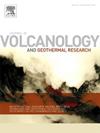波波卡特佩特尔 1996 年和当前岩浆喷发的独特地震和喷发前兆:耦合和流化床事件
IF 2.4
3区 地球科学
Q2 GEOSCIENCES, MULTIDISCIPLINARY
Journal of Volcanology and Geothermal Research
Pub Date : 2024-10-15
DOI:10.1016/j.jvolgeores.2024.108208
引用次数: 0
摘要
我们描述了波波卡特佩特尔火山三种独特的地震类型,它们伴随着 1994 年 12 月最初的喷口清理喷发活动,直至 1996 年前两个圆顶的喷发。我们确定并描述了两类耦合事件:1)痉挛性爆发耦合事件,即火山构造(VT)事件的爆发与大规模喷发爆炸(1994 年 12 月 21 日和 1996 年 3 月 5 日)的耦合;2)爆炸-偶联耦合事件,即第一个事件较深,第二个事件与小规模气体排放或爆炸相关的一对事件。爆炸耦合事件发生在以岩浆灰为主的喷发开始时,其特性对预测波波卡特佩特尔火山的岩浆喷发非常有用。在 1996 年 3 月至 6 月期间,随着头两个圆顶接近地表,可测量的数量,包括第一阶段和第二阶段之间的时间、每日事件的数量以及第二阶段和第一阶段之间的振幅比,都发生了系统性的变化。事件间时间从几十秒缩短到几秒,而振幅比则从大约 2 增至 10 或更多。在最初的穹顶挤出之前和期间,事件数量增加了。这些变化被用来预测前两个穹顶的喷发。我们还报告了伴随喷发的另一种不寻常的低频地震,称为流化床事件。流化床事件发生在 1994 年 12 月 21 日的首次喷发之后,从 1995 年 1 月中旬开始,当时二氧化硫排放量最初升高,导管处于开放状态。1995 年 3 月底至 5 月底,流化床事件开始减弱,二氧化硫排放量也开始减弱。国家灾难预防中心(CENAPRED)对气体、视觉和地震进行了持续观测,从而将气体、岩浆和地震现象直接联系起来。本文章由计算机程序翻译,如有差异,请以英文原文为准。
Unique seismic and eruption precursors to the 1996 and ongoing magmatic eruptions of Popocatépetl: Coupled and fluidized bed events
We describe three unique types of seismicity at Popocatépetl volcano that accompanied the initial vent-clearing eruptive activity in December 1994 through the eruption of the first two domes in 1996. We identify and describe two types of coupled events, 1) spasmodic burst coupled events, a burst of volcano tectonic (VT) events coupled with a large eruptive explosion (21 December 1994 and 5 March 1996), and 2) explosion-couplet coupled events, a pair of events with a deeper first event and whose second event correlates with a small gas emission or explosion. Explosion-couplets occurred with the onset of magmatic ash dominated eruptions and their properties are very useful for forecasting magmatic eruptions at Popocatépetl volcano. Measurable quantities including the time between the first and second phase, daily numbers of events, and the amplitude ratio between the second and first phase systematically changed as the first two domes approached the surface between March and June 1996. Interevent times decreased from many tens of seconds to a few seconds, while amplitude ratios increased from about 2 to 10 or more. Event numbers increased prior to and during initial dome extrusion. These changes were used to forecast the eruption of the first two domes. We also report on another unusual type of low frequency seismicity that accompanied emissions called fluidized bed events. Fluidized bed events occurred following the initial eruption on 21 December 1994, beginning mid-January 1995, when SO2 emissions were initially elevated, and the conduit was open. Fluidized bed events began to wane in late March through the end of May 1995 as did SO2 emissions. Consistent gas, visual and seismic observations by Centro Nacional de Prevención de Desastres (CENAPRED) enabled the direct correlation of the gas, magma, and seismic phenomena.
求助全文
通过发布文献求助,成功后即可免费获取论文全文。
去求助
来源期刊
CiteScore
5.90
自引率
13.80%
发文量
183
审稿时长
19.7 weeks
期刊介绍:
An international research journal with focus on volcanic and geothermal processes and their impact on the environment and society.
Submission of papers covering the following aspects of volcanology and geothermal research are encouraged:
(1) Geological aspects of volcanic systems: volcano stratigraphy, structure and tectonic influence; eruptive history; evolution of volcanic landforms; eruption style and progress; dispersal patterns of lava and ash; analysis of real-time eruption observations.
(2) Geochemical and petrological aspects of volcanic rocks: magma genesis and evolution; crystallization; volatile compositions, solubility, and degassing; volcanic petrography and textural analysis.
(3) Hydrology, geochemistry and measurement of volcanic and hydrothermal fluids: volcanic gas emissions; fumaroles and springs; crater lakes; hydrothermal mineralization.
(4) Geophysical aspects of volcanic systems: physical properties of volcanic rocks and magmas; heat flow studies; volcano seismology, geodesy and remote sensing.
(5) Computational modeling and experimental simulation of magmatic and hydrothermal processes: eruption dynamics; magma transport and storage; plume dynamics and ash dispersal; lava flow dynamics; hydrothermal fluid flow; thermodynamics of aqueous fluids and melts.
(6) Volcano hazard and risk research: hazard zonation methodology, development of forecasting tools; assessment techniques for vulnerability and impact.

 求助内容:
求助内容: 应助结果提醒方式:
应助结果提醒方式:


